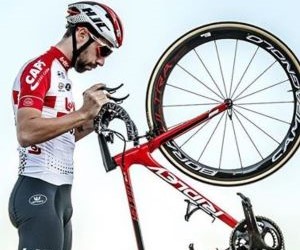Learn how to deal with punctures on long rides with prevention tips, repair techniques, and smart gear choices to keep rolling without stress.
WHAT ARE THE BEST TIPS FOR CYCLING IN HOT WEATHER?
Cycling in hot weather tests both body and mind. High temperatures increase sweat loss, strain the cardiovascular system, and elevate the risk of dehydration or heatstroke. Yet with the right strategies, riding in the heat becomes not only manageable but also an opportunity to build resilience. This guide explores the science and practice of hot-weather cycling, breaking down hydration, clothing, nutrition, and pacing so you can perform your best even under the blazing sun.

Hydration and electrolyte balance
Hydration is the number one priority when cycling in the heat. Your body cools itself primarily through sweating, but this process depletes both fluids and electrolytes. Without replacement, performance drops, cramps set in, and the risk of heat exhaustion rises sharply.
Drinking strategy on the bike
A common mistake is waiting until you feel thirsty to drink. By then, dehydration has already begun. Instead, sip water or sports drinks consistently—about one bottle per hour for moderate rides, and up to two bottles in extreme heat. Using insulated bottles keeps fluids cooler and more palatable.
The role of electrolytes
Electrolytes like sodium, potassium, and magnesium are lost through sweat and must be replenished. Without them, water alone dilutes blood sodium, increasing the risk of hyponatremia. Adding electrolyte tablets or powders to your bottles ensures proper fluid absorption and sustained muscle function.
Drink before, during, and after rides—not just when thirsty.
Use insulated bottles to keep drinks cool.
Add electrolytes to maintain sodium balance.
Aim for 500–1000ml of fluid per hour depending on heat.
Hydration is not just about replacing lost fluids—it’s about enabling your body to continue cooling itself effectively. Proper hydration habits can mean the difference between finishing strong and pulling out early due to heat stress.
Clothing and equipment choices
What you wear and how you equip your bike directly affects heat management. The right clothing helps wick sweat, reflect heat, and allow airflow. Likewise, small equipment adjustments can make hot-weather rides safer and more comfortable.
Lightweight and breathable fabrics
Cycling kits designed for summer use lightweight, moisture-wicking fabrics that speed up evaporation and cooling. Light colors reflect sunlight, while mesh panels improve ventilation. Avoid cotton, which traps sweat and increases chafing risk.
Helmet and accessories
A well-ventilated helmet improves airflow and cooling. Sunglasses with UV protection reduce eye strain, and lightweight gloves protect hands while allowing sweat to evaporate. Arm coolers and neck gaiters soaked in cold water can also provide relief on extreme days.
Wear light-colored, breathable jerseys and bibs.
Use a helmet with ample ventilation.
Protect eyes with UV-blocking sunglasses.
Consider cooling accessories like arm sleeves.
Clothing and equipment may seem secondary to training, but in hot weather, they are essential performance tools. The right setup keeps your body temperature under control and extends the amount of time you can ride effectively.
Pacing, nutrition, and adaptation
Even with hydration and clothing optimized, performance in the heat depends heavily on pacing, nutrition, and how well you adapt to hot conditions. Smart strategies allow you to ride longer without succumbing to overheating.
Adjusting effort levels
Heat increases cardiovascular strain, so your normal power or heart rate zones may feel harder. Lowering intensity, especially early in rides, prevents overheating and allows for steady endurance. Listen to your body—pushing through heat stress can lead to dangerous consequences.
Fueling in the heat
Hot weather suppresses appetite, but fueling remains critical. Consume easily digestible carbs—gels, energy drinks, or fruits—to sustain energy. Salted snacks can also help replenish sodium. Aim for 30–60g of carbohydrates per hour on rides longer than 90 minutes.
Heat adaptation
Gradual exposure helps your body adapt to cycling in the heat. Training for short periods during warm conditions improves sweating efficiency and plasma volume, making hot-weather riding more manageable over time. Avoid jumping straight into long, intense rides on the hottest days.
Ride at reduced intensity during extreme heat.
Consume 30–60g carbs per hour for endurance.
Use salty snacks or drinks to replace sodium.
Adapt gradually with shorter hot-weather rides.
Hot-weather cycling is as much about strategy as fitness. By adjusting pace, fueling smartly, and training your body to handle the heat, you can turn scorching days into successful training sessions instead of survival missions.
YOU MAY ALSO BE INTERESTED






